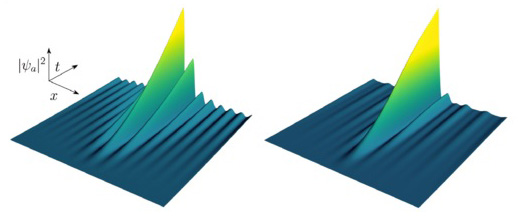Anyone who has flown on vacation this summer may have experienced it first-hand: turbulence is the chaotic movement of air or other particles. This can create vortices that shake travelers on the plane to the core. From the perspective of classical physics, however, such extreme events are not yet fully understood. Physicists at Ruhr-Universität Bochum and City University of New York want to change this: In an article published in the renowned journal Physical Review Letters , they have succeeded in developing a new approach that allows turbulence to be captured in an equation.
If you observe a system over a longer period of time, the following phenomenon occurs: long, regular behavior is interrupted by short, chaotic sections. This is called intermittency. Such irregular fluctuations cannot be captured with a normal distribution according to Gauss. Sumeja Bureković, Prof. Tobias Schäfer and Prof. Rainer Grauer solve this problem in their article entitled "Instantons, Fluctuations, and Singularities in the Supercritical Stochastic Nonlinear Schrödinger Equation". With the publication in Physical Review Letters, they have succeeded in placing themselves in one of the world's leading scientific journals dedicated to the publication of groundbreaking and innovative research results.
Focus on turbulent dynamics in weakly interacting structures
The authors consider a special case of very isolated extreme fluctuations that occurs in the supercritical, non-linear Schrödinger equation. These are only subject to weak interactions. The focus on such dynamics has made it possible to develop an approach that captures these fluctuations 100 percent successfully. In the next step, it can also be transferred to systems that are less isolated and characterized by stronger interactions.
Numerical simulation of turbulence
But how do the researchers make the extreme events understandable and presentable? With the help of instantons: These represent the probabilities of turbulence as a spatio-temporal path integral.
Instantones with smaller and larger localized fluctuation. Figure: Bureković, Schäfer and Grauer
For the first time, the authors have succeeded in quantitatively representing and calculating isolated and localized fluctuations. This new perspective is a major advance in basic physical research into turbulence and could potentially be used for various real-life applications: For example, the equation could be used to make stability calculations of wind turbines much more accurate and adapted to real wind and weather conditions.
The authors - Sumeja Bureković, Prof. Tobias Schäfer and Prof. Rainer Grauer (from left to right).
Cooperation across the globe
The publication of the article is the result of a collaboration that spans several years and national borders. Bureković worked on the application of instantons to the supercritical, non-linear Schrödinger equation as part of her Master's thesis at the Faculty of Physics and Astronomy. She has since successfully completed her Master's degree and started a PhD at the Université Paris-Saclay in France. In fall 2022, she also spent two months abroad with Schäfer in New York. Schäfer is Professor of Mathematics at the City University of New York. His research stay in Bochum in 2012 was the start of the collaboration with Grauer, Professor of Theoretical Physics at Ruhr-Universität, and their joint work on instantons.
You can read the full article here: https://journals.aps.org/prl/abstract/10.1103/PhysRevLett.133.077202 .




